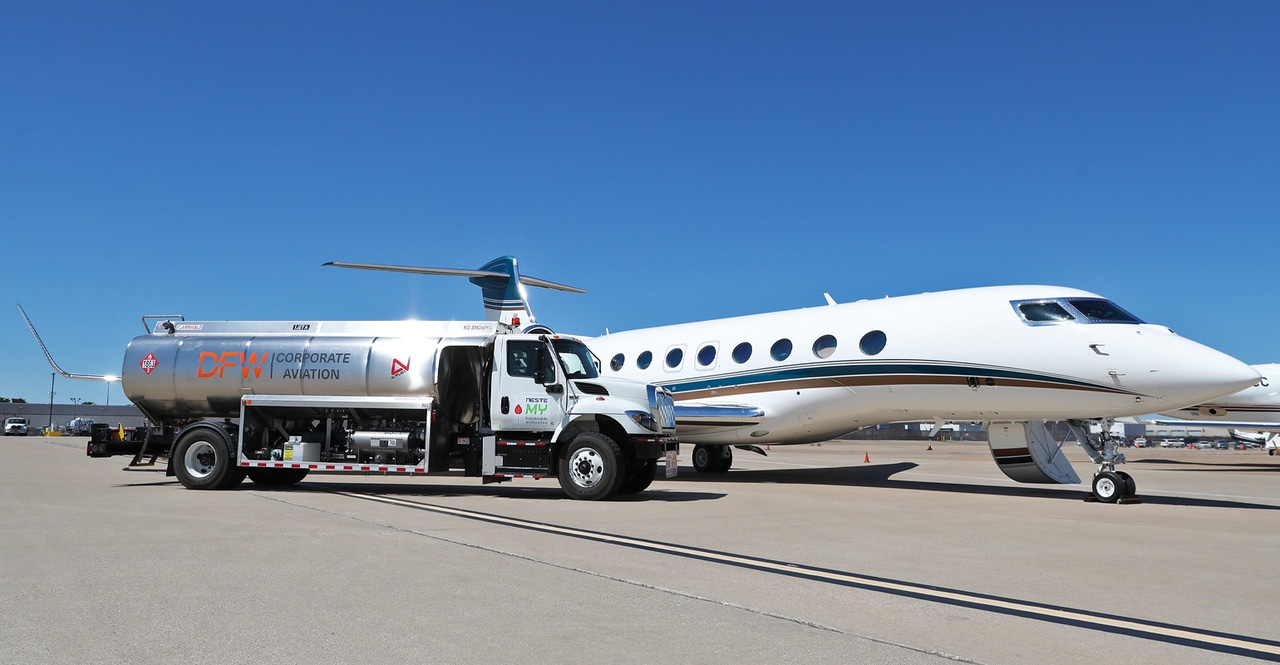DFW Airport Tests Closed-Loop Sustainable Aviation Fuel Model

With the aviation industry and operations that depend on it pushed to reduce their greenhouse gas emissions (GGE), corporate flight departments, logistics companies, and government agencies are looking at sustainable aviation fuel (SAF) to help accomplish this.
Meanwhile the clock is ticking; the global aviation industry has a goal of net-zero carbon emissions by 2050. Airports will play a key role in this transition, says Robert Horton, vice president of Environmental Affairs for Dallas Fort Worth (DFW) Airport. One of the largest airports in the world, it’s already achieved carbon neutrality, and has set the more ambitious goal of net zero for two decades ahead of the global 2050 target. SAF will be one means to try and achieve this: DFW Airport just became the first operation of its kind to test a closed loop model, where oils and grease from its concessionaires were collected and blended with fossil jet fuel and made available to its corporate aviation customers.
While other airports have utilized SAF none till now have generated the feedstock used to produce it onsite.
“The first product was delivered in September; proof of concept was successful; and we will wait to see if DFW will make [the arrangement] more permanent and incorporate SAF into their sustainability metrics,” says Keith Sawyer, manager of Alternative Fuels, Avfuel Corporation, a global supplier of aviation fuel who worked with DFW and with major renewable fuel producer Neste on this demonstration project.
The partners estimate the 7,600-gallon test load has an emissions reduction equivalent to 19 metric tons of CO2.
There are many steps in the production process, but it basically involves collecting the used cooking oil, removing impurities, stripping oxygen molecules, then combining carbon from the waste oil with hydrogen. The product is blended with fossil jet. Over its life, Neste says its SAF reduces greenhouse gas emissions by up to 80% compared to fossil jet fuel, as calculated by established life cycle assessment (LCA) methodologies.
The pilot at DFW and other efforts to advance SAF are early. Today, it’s commercially available in limited quantities, accounting for only .01% of global jet fuel use. Of Avfuel’s 3,000 worldwide locations eight of them sell SAF in North America.
The U.S. government has set its sights on pumping supply and is looking to do it through collaboration with big players. DFW has been a part of this initiative too. In the midst of the airport’s pilot, its CEO, Sean Donohue, joined a White House Round Table on SAF.
“This event brought together multiple federal agencies and public and private sector leaders to discuss how to scale the production and use of SAF domestically and accelerate the decarbonization of the aviation sector,” says Horton. He explains why DFW is vested.
“As an airport, it’s our responsibility to enable our partners’ success in reaching their decarbonization goals, and this pilot project demonstrated the commercial and technical viability of SAF, paving the way for broader use.”
The major Forth Worth hub wants to make SAF available to more of its aviation customers, some of who are private aircraft owners, Fortune 500 corporate flight departments, the Federal Emergency Management Agency (FEMA), sport teams, and others.
Avfuel too is hoping this first closed loop project will lead to bigger things.
“Through this pilot we could demonstrate this circular notion may be replicable at other airports with similar operations that have concessions and a lot of traffic, as well as smaller airports that may want to recycle their oils and greases,” Sawyer says.
Neste currently supplies SAF to 15 U.S. airports across six states, including San Francisco International Airport (SFO), San Jose International Airport (SJC), William P. Hobby Airport in Houston (HOU), and Austin-Bergstrom International Airport (AUS). The company would not disclose SAF and fossil jet blend rates for individual supply agreements. But regulations currently allow for an up to 50-50 blend. Neste says it’s working with European aerospace corporation Airbus and other businesses to test 100% SAF in aircraft.
Policy appears to be working in the favor of operations like Neste, Avfuel, and DFW as they join to try and advance product. Under the Carbon Offsetting and Reduction Scheme for International Aviation (CORSIA) agreement, the use of SAF by airlines will count toward their CO2 emissions reduction efforts. And SAF is a key component of the recently released 2021 U.S. Aviation Climate Action Plan, outlining how the industry will work to reach net-zero emissions by 2050.
“Together [DFW, Neste, and Avfuel] are charting a bold new flight path that shows airports how they can achieve their climate goals faster and ultimately enable flight operators, businesses, and passengers to fly with a smaller carbon footprint,” Chris Cooper, Neste’s vice president of Renewable Aviation in North America said in a statement. “We’re able to do this because all parts of the SAF value chain came together—the airport, the fuel supplier, and the producer.”
Theodore Rolfvondenbaumen, communications manager, Neste echoes Cooper’s take on the power of collaboration.
“Neste is working to transform the fuel supply chain for aviation, which is still dominated by the fossil fuel industry. Doing this is team play, requiring partnerships and collaboration across every step of that supply chain.
Neste produces sustainable aviation fuel. Avfuel has the expertise and distribution infrastructure to get our SAF into airports and wings. DFW represents the end user, and their commitment to support SAF sends an important market signal. Together, we have created a clear line from producer through distributor to customer.”
About the Author
You May Also Like




.png?width=300&auto=webp&quality=80&disable=upscale)